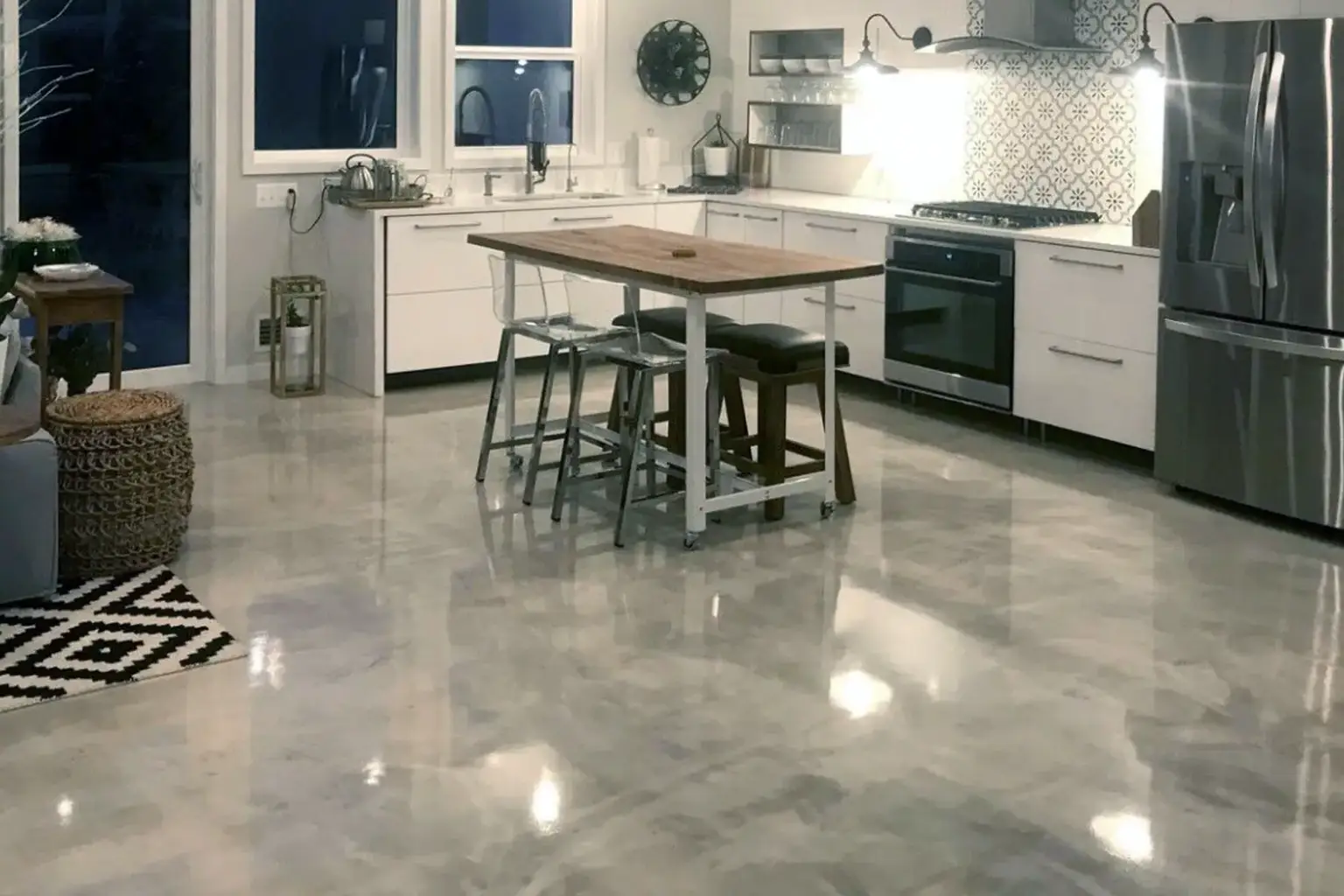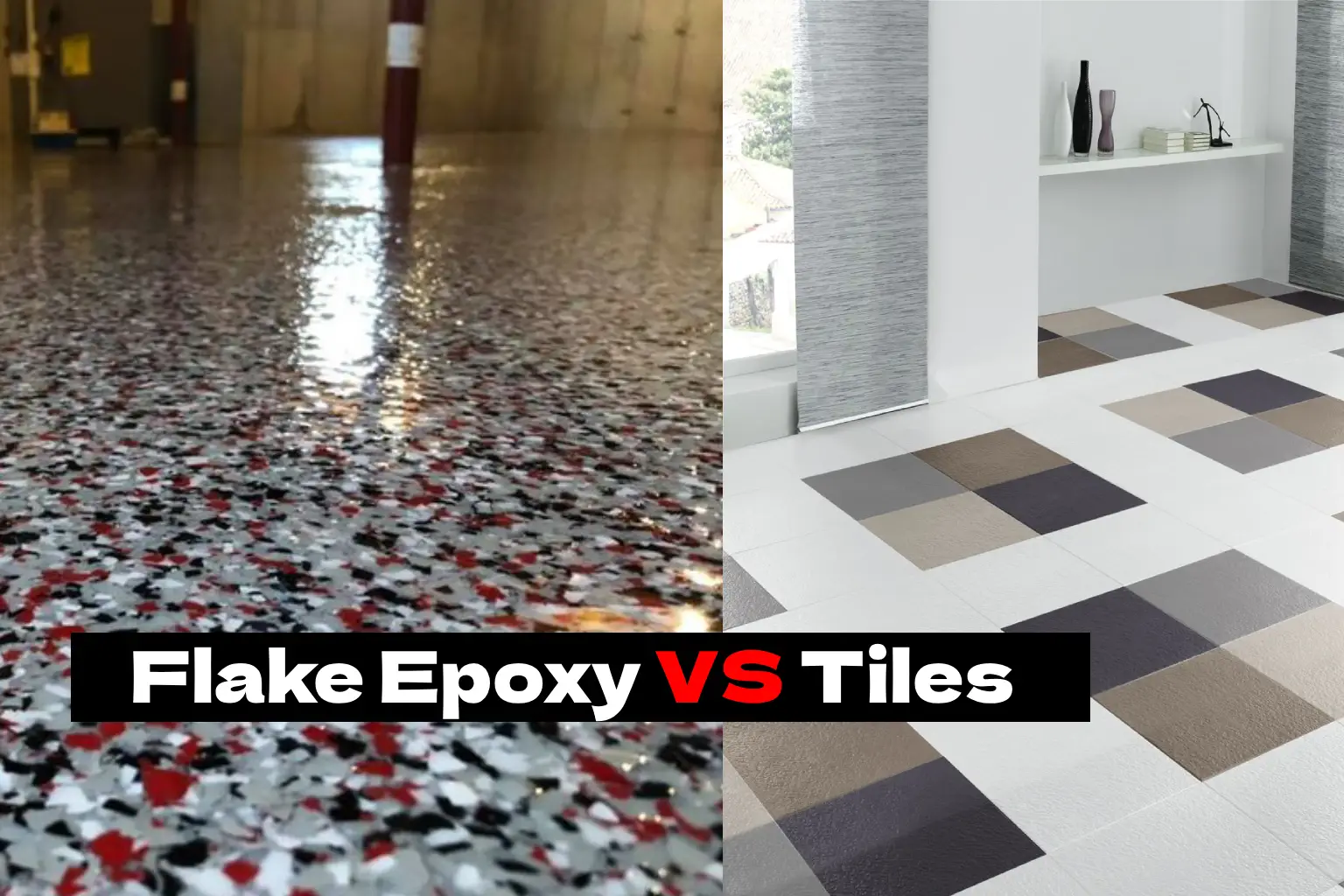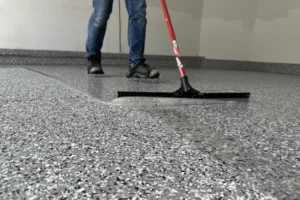Selecting suitable flooring is about more than aesthetics. It is about strength, durability, and value over time. Flake epoxy flooring and tiles are two of the more common flooring types for both residential and commercial uses.
Both flooring types offer style and performance you can count on for the long haul, but they are different in how they handle use and abuse. This comparison will help you see side-by-side what flooring stands longer under all types of pressure and what may be the best flooring type for you.
Material Composition and Structure
Knowing what each type of flooring is made of will help you understand how it lasts. Both flake epoxy flooring and tiles are made of different materials and builds. These aspects alter their durability, aesthetics, and efficiency over time.
Flake Epoxy Flooring
The composition of flake epoxy flooring is epoxy resin mixed with a hardener, combined with colorful flake designs scattered over the entire surface for visual texture and aesthetic style. A clear topcoat locks the flakes in place once dry. The end product is a solid, strong, smooth, and shiny surface that stands up to heavy wear.
Tiles
Tiles are made from either ceramic, porcelain, or natural stone – all of which are fired to a hard density at the highest temperature possible. Porcelains are denser and less absorbent than ceramics, resulting in greater water resistance.
Stone tiles (marble’s or granite’s natural properties) provide a more natural flooring look and demand greater maintenance.
Structure and Strength
Epoxy is seamless and bonds to the concrete substrate tightly, making it more durable and resistant to cracking. The tile’s strength is dependent on the bonding with the grout lines; these grout lines can wear out, weaken, and become dirty over time.
Epoxy provides excellent durability and can stand up to cracking over time through its hard-surface protection characteristics and strength.
Resistance to Impact and Heavy Use
Both flake epoxy flooring systems and flooring tiles are durable, but they act differently under pressure and heavy use. Here’s how they compare:
Flake Epoxy Flooring:
- Sustains heavy foot traffic and machines well.
- The epoxy is capable of flexing a bit, and it is more likely not to crack, unlike the tile.
- Good selection for garages, workshops, or commercial use.
- No seams on the surface leaves no weak points or breaks.
Tiles:
- Strong enough for day-to-day use, but the tile itself can crack with heavy use.
- Whenever a tool or something heavy is dropped, there’s a good chance there will be chips or breaks.
- Over time, the grout lines can wear off and come loose.
- Best for lighter use in rooms like bathrooms and kitchens.
Flake epoxy flooring performs better under constant pressure and heavy loads. Tiles are sturdy but more likely to crack or chip with impact.
Water and Chemical Resistance
In places like garages, water and chemical spills are likely to occur often. The way that each type of flooring performs under these conditions can be a very impactful factor.
Flake Epoxy Flooring
- Flake epoxy offers a seamless surface that prevents water or oil from seeping through the floor.
- Ideal for garages, workshops, and basement floors.
- Water and chemicals will not stain. It resists oil stains and cleaning agents.
- Can be wiped clean without marking or damaging the surface.
Tiles
- Water can get through grout lines and cause stains or mold.
- Chemicals will cause the grout to either fade or break down.
- Grout usually needs to be sealed to help it to withstand moisture.
- Not a good choice for garages that often have spills or leaks.
Flake epoxy flooring provides superior water and chemical protection for use with durable floor systems, especially for garage spaces. Tile flooring requires additional intervention and sealing to be able to sustain wet or harsh conditions.
Longevity and Maintenance
Both flooring alternatives can stand the test of time if installed and maintained correctly. The longevity and maintenance of both materials is seen as follows:
Flake epoxy flooring
- Can last 20-25 years, depending on installation and maintenance.
- Requires minimal maintenance with light regular cleaning.
- Resealing or regrouting is usually not a requirement.
- Seams will keep dirt, moisture, and moisture contaminants away.
- After years of upkeep, a coat of resin can refresh the shine.
Tiles
- Generally, they last around 10-15 years with proper installation.
- It should be cleaned and sealed regularly.
- May require re-grouting.
- Cracked or loose tiles must be replaced individually.
- Tiles can look great with attention, but will take more effort.
Factors to Consider When Repairing and Replacing
Flake epoxy floors are easy to maintain and repair. Small scratches or chips can simply be sanded down and recoated with epoxy. Since it’s a seamless surface, your repair won’t show visible patches or indications that it was repaired. This makes it less expensive in the long run.
Tiles are definitely more of a challenge when it comes to repair. You may have to remove and replace a cracked tile or tiles, and you probably will not be able to find the same color and pattern for the tile. You may also have to re-grout the tile lines when it’s all finished, increasing both the cost and time.
Cost vs Value of Durability
It’s worthwhile to consider cost and durability when choosing between flake epoxy flooring and tiles. Epoxy flooring cost is often less to install, and, if properly maintained, will last longer.
Tiles may be less expensive upfront, but costs from repairs and grout maintenance tend to accumulate. Overall, epoxy flooring provides better value in terms of durability for areas subjected to heavy use, such as garage flooring or workshop flooring.
| Feature | Flake Epoxy Flooring | Tiles |
| Installation Cost | $5–$10 per sq ft typical | Kitchens, bathrooms, and living areas |
| Durability | Very high | Moderate to high |
| Maintenance Cost | Low | Medium to high |
| Repair Difficulty | Easy | Moderate to hard |
| Expected Lifespan | 15–20 years with proper installation and care | 10–15 years typical, depending on quality & installation |
| Best Use Areas | Garages, workshops, basements | Kitchens, bathrooms, living areas |
Applications of Flake Epoxy vs Tile Flooring
Flake epoxy is most effective in environments requiring durability and easy to clean. Epoxy flake flooring is appropriate in garages, workshops, basements, and even commercial settings. It has a smooth and seamless finish that resists spills, tools, and high-traffic applications.
Tiles are the superior option in applications where design and style are most important. The tile looks good in the kitchen, bathroom, and living room. They provide many colors and patterns to provide more decorating options for indoor spaces.
Conclusion
Tiles and flake epoxy flooring are durable and stylish, but they meet different needs. Tiles offer timeless elegance to an indoor space, while epoxy flake floors provide superior strength, maintenance, and longevity, especially in the garage or workspace. If you’re looking for a long-lasting and beautiful floor that is easy to maintain, epoxy is the best option. Upgrade your floors with Epoxy Shine today. Get a strong, seamless, and glossy surface that transforms your space, built to last for years.








